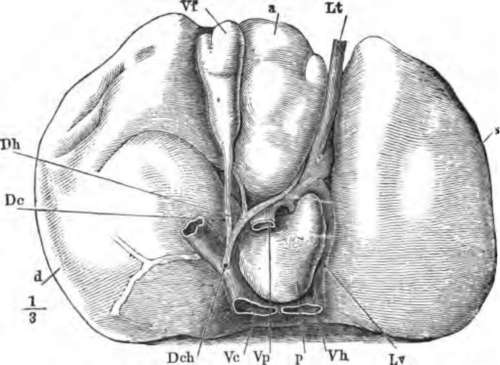The Liver
Description
This section is from the book "The Human Body: An Elementary Text-Book Of Anatomy, Physiology, And Hygiene", by H. Newell Martin. Also available from Amazon: The Human Body.
The Liver
Besides the secretions formed by the glands imbedded in its walls, the small intestine receives those of two large glands, the liver and pancreas, which lie in the abdominal cavity. The ducts of both open, by a common aperture, into the duodenum about 4 inches (10 centimeters) from the pylorus.
The liver is the largest gland in the body, weighing from 50 to 60 ounces (1400 to 1700 grams). It is situated in the upper part of the abdominal cavity (le, le', Fig. 4), rather more on the right than on the left side, immediately below the diaphragm. The liver is of dark reddish-brown color, and of soft friable texture. The vessels carrying blood to the liver (Fig. 52) are the portal vein, Vp, (p. 236) and the hepatic artery; both enter it at a groove on its under side, and there also a duct passes out from each half of the organ. The ducts unite to form the hepatic duct, Dh, which meets the cystic duct, Dc, proceeding from the gallbladder, Vf, a pear-shaped sac in which the bile or gall formed by the liver accumulates when food is not being digested in the intestine. The common bile duct, Dch, formed by the union of the hepatic and cystic ducts, opens into the duodenum.
Describe the colon. What is the sigmoid flexure? What is the terminal portion of the alimentary canal named? How does the-mucous lining of the large intestine differ from, and how does it resemble that of the small ?
Where is the ileo-colic valve? How is it formed? What is its function?
What large glands pour their secretion into the small intestine? Where are they situated? Where do their ducts open?
What is the largest gland in the body? What is its weight? Where is it placed?

Fig. 52. The under surface of the liver, d. right, and s, left lobe; Vh. hepatic vein; Vp, portal vein; Vc, vena cava inferior; Dch, common bile duct; Dc. cystic duct; Dh, hepatic duct; Vf, gall-bladder.
Describe the color and texture of the liver. What vessels bring blood to it? Describe the arrangement of its ducts. What is the gall-bladder? Where does the common bile duct open?
The Functions Of The Liver
The size of the liver is related to the fact that the organ plays a double function; on the one hand it is a digestive gland secreting bile; on the other, its cells serve to store up, in the form of a kind of animal starch, called glycogen, excess of starchy or sugary food absorbed from the intestine during the digestion of a meal, and then to gradually dole this out to the blood for general use by the organs of the body until the next meal is eaten.
Continue to:
